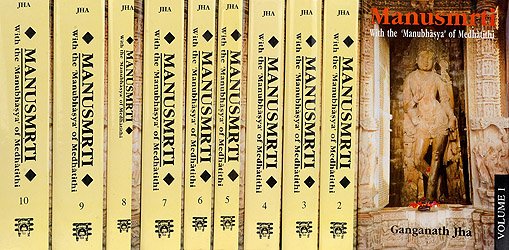Manusmriti with the Commentary of Medhatithi
by Ganganatha Jha | 1920 | 1,381,940 words | ISBN-10: 8120811550 | ISBN-13: 9788120811553
This is the English translation of the Manusmriti, which is a collection of Sanskrit verses dealing with ‘Dharma’, a collective name for human purpose, their duties and the law. Various topics will be dealt with, but this volume of the series includes 12 discourses (adhyaya). The commentary on this text by Medhatithi elaborately explains various t...
Verse 2.26 [Duties and Sacraments]
Sanskrit text, Unicode transliteration and English translation by Ganganath Jha:
वैदिकैः कर्मभिः पुण्यैर्निषेकादिर्द्विजन्मनाम् ।
कार्यः शरीरसंस्कारः पावनः प्रेत्य चैह च ॥ २६ ॥vaidikaiḥ karmabhiḥ puṇyairniṣekādirdvijanmanām |
kāryaḥ śarīrasaṃskāraḥ pāvanaḥ pretya caiha ca || 26 ||For the twice-born persons corporeal consecration, beginning with ‘Conception,’ should be performed with auspicious Vedic rites; it purifies in this world and also after death.—(26)
Medhātithi’s commentary (manubhāṣya):
The ‘Vedic rites’ spoken of here are mantra-recitations. ‘Veda’ here stands for mantras; and what ‘arises out of them’ (which is what is expressed by the affix in ‘Vaidikaiḥ’) is the ‘reciting’; hence the nominal affix ‘ṭhañ’ comes under the provisions of the Vārtika on Pāṇini, 4. 3. 60.
Or, the word ‘vaidika’ (Vedic) may he taken as figuratively applied to the rites, on the ground of their source lying in the Veda. ‘Karma,’ ‘Rites,’ would, in this case, stand for the act constituting the procedure; and hence becomes possible the differentiation and the relation of cause and effect (between the Karma and the Saṁskāra which is expressed in the assertion—‘the consecration, saṁskāra, should he performed by means of the Rites?
‘Conception’—is the depositing of the semen in the womb, and ‘niṣekādiḥ’ stands for that body of sacraments to he described below, which liegins with the said ‘Conception’ and ends with ‘Initiation’ ( Upanayana). The singular number in ‘Śarīrasaṁskāraḥ,’ ‘corporeal consecration,’ is due to the whole body of sacraments being taken collectively. ‘Consecration’ means the preparation of a qualified body; and the Eeveral sacraments serve to produce in the body special qualifications.
This is what is meant by the term ‘pāvanaḥ,’ ‘it nurifies,’ removes impurities.
‘In this world and also after death’.—This means that the person duly consecrated becomes entitled to the performance of all those acts that, like the Kārīri and other sacrifices, lead to material results, -as also those that, like the Jyotiṣṭoma etc., bring spiritual rewards; and hence the consecrations are of use in both worlds.
‘Puṇyaiḥ’—‘auspicious,’ ie., propitious; i.e., they bring good luck and remove bad luck. Thus there is a clear difference between the word ‘puṇy a’ and ‘pāvana’ here.
‘For the twice-born persons,’—this serves to exclude the Śūdras. This word serves to point out who are the persons to be consecrated; and it is only by indirect indication that the three higher castes arc understood to be meant; for before consecration, they are not yet ‘twice-born’ (the ‘second birth’ consisting of the consecration).—(26)
Explanatory notes by Ganganath Jha
‘Vaidikaiḥ karmabhiḥ’.—The term ‘vaidika-karma’ here stands for Vedic mantras;—or for rites prescribed in the Veda. Both explanations are found in Medhātithi and Govindarāja; Kullūka notes only the latter explanation.
This verse has been quoted in the Vīramitrodaya (Saṃskāra, p. 132) as laying down the necessity of performing the Saṃskāras. Here also both the above explanations are noted.—It explains the term ‘śarīra’ in the compound ‘Śarīrasaṃskāraḥ’ to stand for the constituents of the body.—‘In this world and also after death’—has been explained as implying that the Saṃskāras help ‘after death’ by enabling the man to perform such sacrifices as lead him to heaven, and they help ‘in this world’ by enabling him to perform such sacrifices as the Kārīrī and the like, which bring desirable results in the world, in the shape of rain, children and so forth.—It is quoted in the Smṛticandrikā (Saṃskāra, p. 36), to the effect that sacramental rites are performed with Vedic Mantras in the ease of the Twice-bom persons only; it adds that these sacraments are called ‘pāvana’, ‘purificatory’ of the person, because, performed with Vedic Mantras, they serve to destroy sins.
Comparative notes by various authors
Gautama-Dharmasūtra, 7.7.—‘Sanctified by means of the forty sacraments.’
Gautama-Dharmnsūtra, 7.14.—‘Four are the Vedic observances.’
Yājñavalkya, 1.10.—‘From Conception till Death, the rites of the Brāhmaṇa, the Kṣatriya and the Vaiśya are performed with Mantras.’
Yama (Vīra-Saṃskāra, p. 132).—‘The Śūdra also should be sanctified; hut without Mantras,’
Baijavapa (Ibid).—‘For the Śūdra also, the following sacraments have been ordained—Niṣeka, Puṃsavana, Sīmantonnayana, Jātakarma, Nāmakaraṇa, Annaprāśana, and Chaula,—as to he done without Mantras.’
Jātūkarṇya (Ibid, p. 134)—‘For the Śūdra, there is Marriage as also the Final (Death) Rites.’
